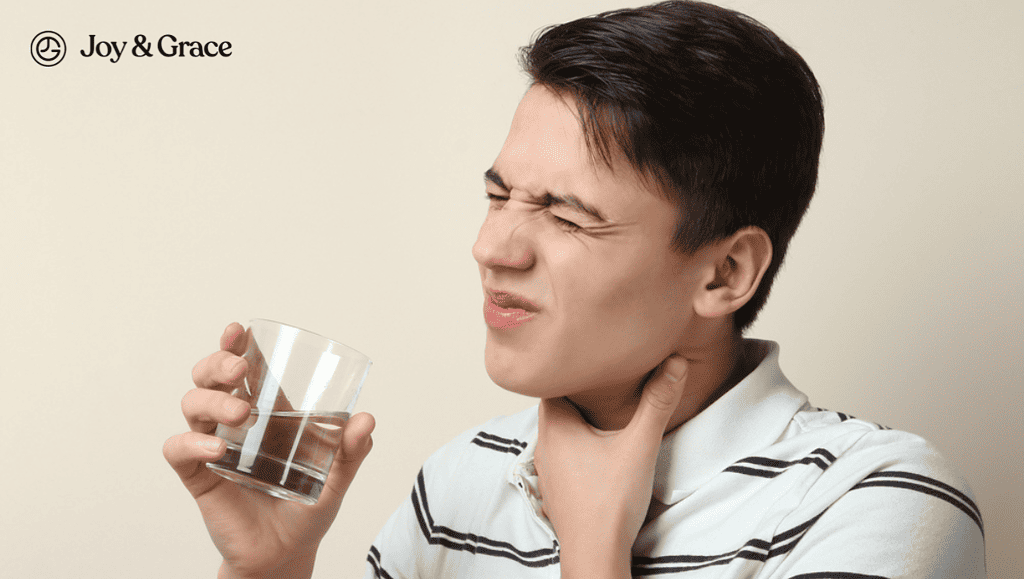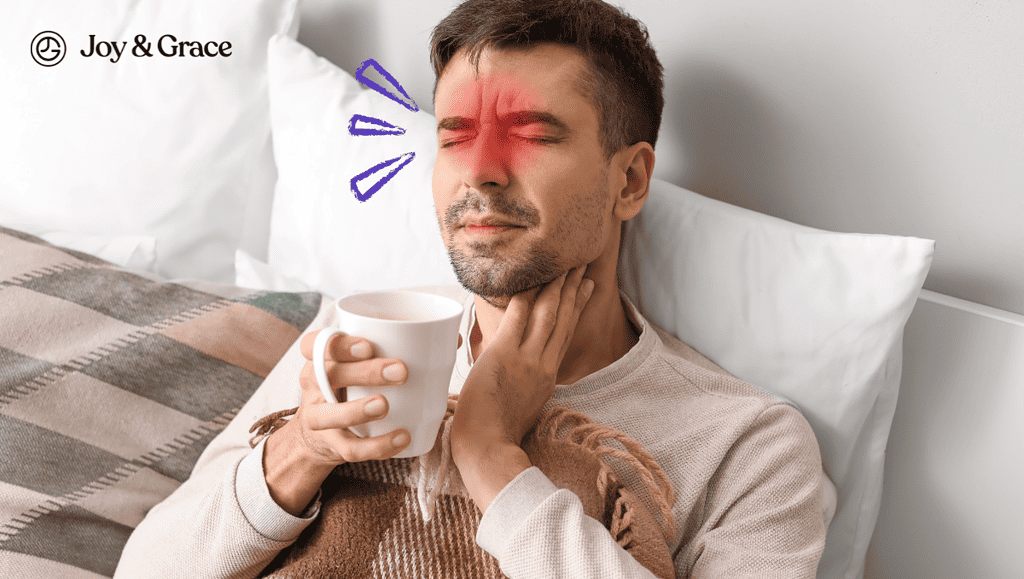Neck spasms are a common problem that can cause considerable discomfort and pain for many individuals. These involuntary contractions of the neck muscles can occur for various reasons.
In this article, we'll explore some of the most common causes of neck spasms. We'll also offer practical tips for managing the pain and discomfort they can cause. With the right approach and patience, you can reduce the impact of neck spasms on your life and get back to doing the things you love.
Why Do I Have Extremely Painful Muscle Spasms In My Neck?
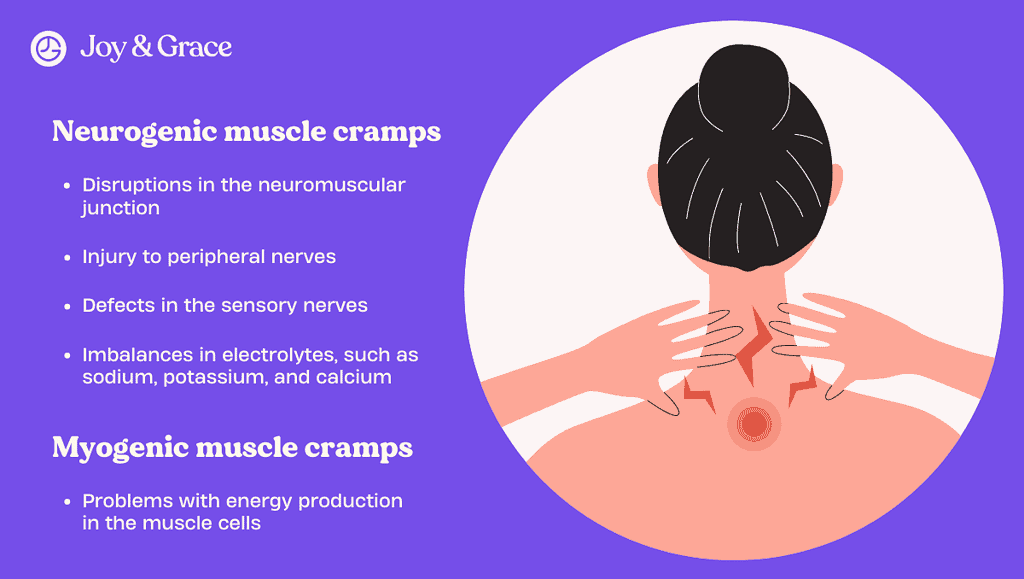
Neck spasms, or cervical muscle spasms, happen when the muscles in your neck suddenly or uncontrollably tighten up and fail to relax. Not all neck spasms cause pain, but when they do, they are called neck cramps. But most people use these terms interchangeably.
The exact mechanism of how muscle spasms or cramps happen is still unknown. However, some researchers believe this may be either neurogenic (nerve-related) or myogenic (muscle-related).
Neurogenic muscle cramps are muscle spasms due to problems in the nervous system.
These cramps can be caused by various factors, such as:
- Disruptions in the neuromuscular junction (where nerves and muscles connect).
- Injury to peripheral nerves.
- Defects in the sensory nerves that detect changes in muscle length and tension.
- Imbalances in electrolytes, such as sodium, potassium, and calcium.
On the other hand, myogenic muscle cramps happen because of problems with energy production in the muscle cells. The muscle cells do not have enough energy to relax properly, which causes them to remain contracted and results in a muscle cramp.
According to a study, muscle spasms cause pain because the muscles aren't getting enough blood flow. This leads to a build-up of acid in the muscles and the release of chemicals that cause pain.
What Causes Severe Muscle Spasms In The Neck?

A variety of factors can cause neck spasms. These include:
- Poor posture
One common cause of neck spasms is poor posture. When you spend long hours hunched over your computer or staring down at your phone, your neck is under a lot of stress. Over time, this strain can lead to muscle spasms and pain.
- Injury
An injury to the neck, such as whiplash from a car accident, can cause muscle and ligament strain, which can lead to neck spasms.
- Stress
When we're stressed, our muscles tense up, and this can cause spasms in the neck muscles.
- Dehydration
Muscle cramps can occur more frequently during exercise in hot weather due to the loss of fluids, salt, and minerals from sweating. These essential nutrients are necessary for proper muscle function.
- Poor sleep habits
Sleeping in an awkward position (such as sleeping on your stomach) or on an uncomfortable pillow can cause neck muscles to strain, leading to spasms.
What Diseases Cause Painful Neck Spasms?
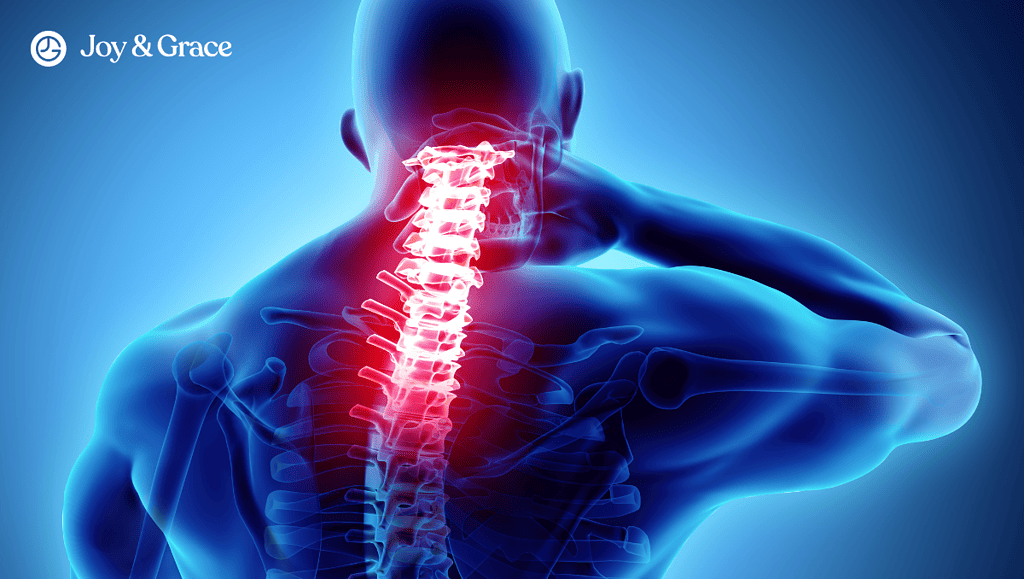
While neck spasms are mostly harmless and caused by the above factors, they may be a symptom of a more serious condition.
It’s important to note that these conditions do not present with neck spasms as their only symptom.
There are several diseases and conditions that can cause painful neck spasms, including:
- Herniated disc
A herniated disc occurs when the soft, jelly-like material inside the disc pushes out.
If a herniated disc occurs in the neck, it can put pressure on the nerves that run through the spinal cord and cause muscle spasms and pain.
- Osteoarthritis
Osteoarthritis can cause inflammation and deterioration of the joints in the neck, which can lead to muscle spasms and pain.
- Mechanical dysfunction
This includes issues such as misaligned vertebrae or muscle imbalances, which can cause painful muscle spasms in the neck.
- Peripheral neuropathy
Damage to the nerves that supply the muscles in the neck can also cause painful spasms and weakness.
- Myofascial pain syndrome
This chronic pain disorder is characterized by the development of muscle trigger points. These trigger points can cause painful spasms. When this happens in the neck, it’s called cervical myofascial pain.
- Cervical dystonia
Cervical dystonia, or torticollis, causes involuntary muscle contractions in the neck. This can lead to abnormal head posture and painful spasms.
Cervical dystonia is not the same as neurogenic muscle cramps. The exact mechanism behind cervical dystonia is not fully understood. It is believed to involve a problem with the basal ganglia, a group of brain structures responsible for controlling movement.
The basal ganglia may send abnormal signals to the neck muscles. This results in involuntary contractions and abnormal movements.
- Fibromyalgia
This chronic pain disorder can cause muscle pain and stiffness, including in the neck muscles.
- Spinal stenosis
Spinal stenosis is when the spaces in your spine get smaller, putting pressure on your nerves. This can cause muscle spasms and pain in your neck and other body parts.
- Meningitis
This is an inflammation of the membranes that surround the brain and spinal cord, which can cause neck stiffness and muscle spasms.
- Ankylosing spondylitis
This is a type of arthritis that primarily affects the spine and can cause stiffness and pain in the neck and other joints.
- Cervical spondylosis
This condition involves the wear and tear of the discs and vertebrae in the neck, which can cause pain, stiffness, and muscle spasms.
To repeat once more: These diseases do not usually cause muscle spasms as their main symptom. They cause many symptoms, with muscle spasms being occasionally reported in some people. In fact, if you’re suffering from muscle spasms only, it probably means you do not have any of these diseases mentioned.
What Vitamin Deficiency Causes Neck Spasms?
One vitamin deficiency that may be associated with neck spasms is vitamin D deficiency.
Many people are deficient in vitamin D, especially if they have limited exposure to sunlight. Vitamin D is essential for healthy bones and muscles, and a deficiency can lead to muscle weakness and spasms.
According to a study, people with chronic neck pain have lower vitamin D levels than those without neck pain.
Other mineral and vitamin deficiencies that may be associated with neck spasms include:
- Vitamin B12
- Magnesium
- Calcium
- Sodium
- Potassium
What Does A Neck Spasm Feel Like?
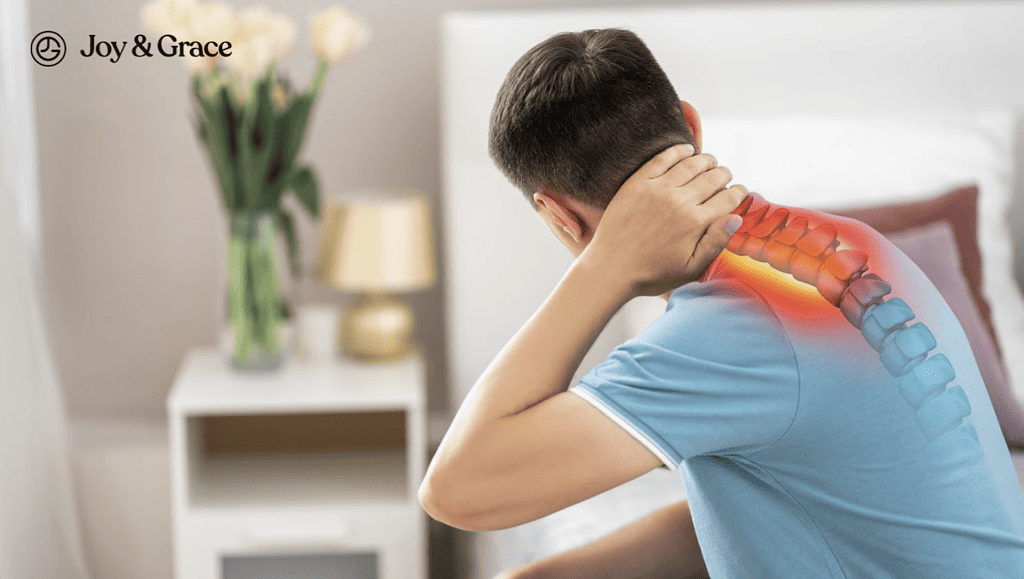
A neck spasm can feel like:
- Twitching of the neck muscles
- A sudden and severe sharp pain
- A deep or heavy ache
- A tingling or “pins and needles” sensation
Additionally, neck spasms can lead to:
- Headache
- Dizziness
- Stiff neck
- A neck that feels tight and difficult to move
- Pain that worsens when moving your head
How Long Does A Severe Neck Spasm Last?
The duration of a severe neck spasm varies from person to person. Muscle spasms can last from a few seconds to 15 minutes or longer.
However, in general, the length of time it lasts depends on the severity of the spasm and the underlying cause. For some people, a severe neck spasm may last a few hours, while for others, it may persist for several days or weeks.
The underlying cause of the spasm also plays a significant role in determining how long it lasts. For example, if the spasm is caused by poor posture or a strained muscle, it may last several days and start to ease up as the muscle heals.
However, if a more serious medical condition causes the spasm, it may take longer to recover, sometimes weeks or even months.
How Long Is Too Long For A Muscle Spasm?
As mentioned earlier, a muscle spasm can last seconds to a few minutes. However, if muscle spasm persists for an extended period, it may indicate an underlying medical condition that requires attention.
If a muscle spasm lasts longer than 15 minutes or occurs frequently and severely, it may indicate a more severe condition. In such cases, it is recommended to consult a healthcare professional for proper diagnosis and treatment.
How Is Neck Spasm Diagnosed?

The diagnostic process starts with a conversation about your medical history and lifestyle. You will need to answer questions about the following:
- Past illnesses
- Injuries
- Surgeries
- Current medications or supplements.
- Daily activities
- Work environment
- Other factors that could be contributing to your painful neck spasms
Next, doctors will conduct a physical examination. Your healthcare provider will observe your:
- Posture
- Range of motion
- Mobility
- Reflexes
- Strength
- Sensation in your neck and upper extremities
In some cases, imaging tests may be used to identify any structural abnormality in your spine and the surrounding tissues. These can include:
- X-rays
- MRI
- CT scans
Based on the results of your evaluation, your healthcare provider will work with you to develop a treatment plan. They will also discuss lifestyle modifications to help relieve and prevent neck spasms.
Is Neck Muscle Spasm Curable?
The answer to this question is complex. Again, everything depends on what’s causing your neck spasms.
If the spasm is caused by poor posture or stress, it can often be treated with simple measures and lifestyle changes. These treatments can help relieve muscle tension, reduce inflammation and pain, and promote healing. We’ll talk more about these measures later.
On the other hand, if a more serious underlying condition causes neck spasms, the treatment may be more complex. Medical intervention may be necessary, such as stronger medication, surgery, or injections.
And even then, there’s no guarantee that you won’t experience neck spasms again. If your neck spasms are caused by a chronic condition, such as ankylosing spondylitis, neck spasms may recur. But if you keep the disease under tight control, you may remain neck spasm free.
What Is The Best Medicine For Neck Spasms?
One of the most common treatments for neck spasms is medication. Several different types of medication can help manage the pain associated with neck spasms.
Here are some medications commonly used to treat painful neck spasms:
- Muscle relaxants to help ease muscle tension and reduce spasms (We have a detailed list just after this section).
- Nonsteroidal anti-inflammatory drugs (NSAIDs) to reduce pain and inflammation.
- Acetaminophen to relieve pain.
- Opioids may be prescribed for severe pain. But they are generally used cautiously and for short periods due to potential risks and side effects.
- Topical creams or ointments containing menthol or capsaicin to help provide temporary pain relief.
- Anticonvulsants may be used for nerve-related pain or muscle spasms.
- Steroid injections into the affected area may be used to reduce inflammation and relieve pain.
- Botox (yes, that botox) may also be used for neck spasms caused by cervical dystonia.
What Is The Best Muscle Relaxer For Neck Spasms?
Finding the right muscle relaxer can make all the difference when dealing with neck spasms. But with so many options available, it can be hard to figure out where to start. Here, we'll break down some muscle relaxers used for neck spasms.
Antispasmodics
These are a type of medication used to relieve muscle spasms and associated pain (antispasmodics literally means anti-spasm drugs). Here are some common antispasmodics and their uses:
- Cyclobenzaprine (Flexeril or Amrix)
This generic muscle relaxant is often used short term to treat muscle spasms and pain related to sprains and strains. It is taken at bedtime for two to three weeks. Common side effects include:
- Drowsiness
- Dry mouth
- Dizziness
- Fatigue
- Methocarbamol (Robaxin)
This medication is commonly used to treat severe muscle spasms, back pain, and tetanus spasms. It is administered orally or by injections. You may experience the following:
- Drowsiness
- Dizziness
- Blurred vision
- Injection site reactions
- Other antispasmodics:
- Metaxalone (Skelaxin)
- Carisoprodol (Soma)
- Chlorzoxazone (Lorzone)
- Orphenadrine (Norflex
Antispastics
These muscle relaxers primarily treat spasticity. Spasticity is a condition where certain muscles in the body become stiff and difficult to move, making it hard to control movements. It is caused by an imbalance in the signals between the muscles and the brain, often due to nerve or spinal cord damage.
Here are some common antispastics:
- Baclofen
- Tizanidine
- Dantrolene
Benzodiazepines such as diazepam (Valium) can also be used to treat muscle spasms. They help by decreasing the hyperexcitability of neurons that may be causing your painful neck spasms.
How Do I Relieve A Neck Muscle Spasm?

Here are some tips on how to relieve a neck muscle spasm.
1. Use Ice
Ice can also help reduce pain and inflammation. Wrap an ice pack in a towel and apply it to the affected area for 15-20 minutes. Make sure to take breaks to avoid damaging your skin. You should ice your neck for the first 48-72 hours, then use heat.
2. Apply Heat
Applying heat to the affected area can help to relax the muscles and reduce the pain. You can use a heating pad or a hot towel. Make sure not to apply the heat directly to your skin, and avoid using heat for more than 20 minutes at a time.
3. Stretch
Gently stretching can help to relieve a neck muscle spasm. Start by slowly moving your head from side to side, then up and down. Don't force your movements, and stop if you feel any pain.
4. Take Over-the-Counter Medication
Over-the-counter pain relievers can help to reduce pain associated with muscle spasms. Make sure to follow the instructions on the label and don't exceed the recommended dosage.
5. Relaxation techniques
Relaxing techniques such as deep breathing, meditation, or yoga can help reduce muscle tension and ease spasms.
6. Rest
In some cases, the best treatment for neck spasms is simply resting. Taking a break from activities aggravating the condition can give your muscles time to heal.
7. Physical therapy
Physical therapy can help strengthen your neck muscles and improve your range of motion. Your physical therapist may also recommend exercises to reduce spasms and alleviate pain.
8. Try Massage
Massaging the affected area can help to relieve a neck muscle spasm. Use gentle pressure and circular motions to massage the area. You can also try using a foam roller or massage ball.
Remember to listen to your body and stop any activities that cause pain or discomfort.
How Do You Massage A Neck Spasm?
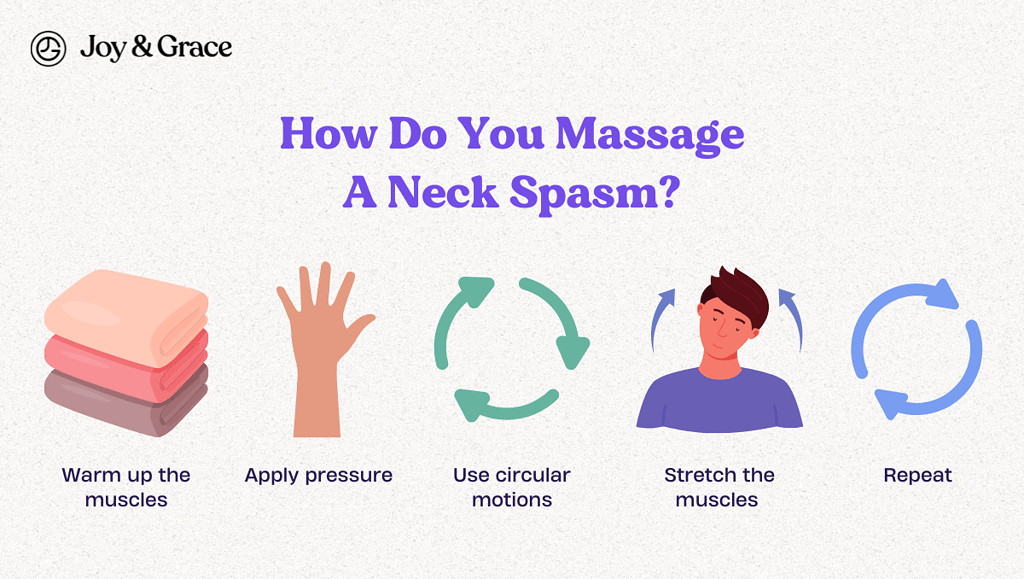
Massage therapy can be a great way to ease neck spasms and relieve tension in the surrounding muscles. Here are some simple and effective techniques you can use at home to massage a neck spasm:
- Warm up the muscles
Before you begin, it's important to warm up the muscles around your neck. You can apply a warm towel, heat pad, or a hot shower for a few minutes. This will help to increase blood flow and loosen up the muscles.
- Apply pressure
Use your fingers to apply gentle pressure to the affected area. Start with light pressure and gradually increase the pressure. Just make sure you don’t hurt yourself by pressing too hard.
- Use circular motions
Using your fingertips, rub the muscles around the spasm in a circular motion. Keep the pressure firm but comfortable, and repeat each circular motion several times.
- Stretch the muscles
After you've massaged the muscles around the spasm, try to stretch them out gently. Slowly move your head from side to side or up and down. This will ease any tension built up in the muscles.
- Repeat
If the neck spasm persists, repeat this process several times daily until the symptoms improve.
What Are Some Exercises For Neck Spasms?
Luckily, some exercises can help relieve painful neck spasms and help you feel better. Here are some exercises you can do at home to alleviate your neck spasms:
- Posture exercises
Proper posture is essential for reducing the frequency and severity of neck spasms. Simple exercises like sitting up straight, and aligning your ears with your shoulders, can be effective. Repeat this throughout the day to help correct your posture.
- Relaxation exercises
Stress can contribute to neck spasms; relaxation exercises can help reduce stress levels. You can try deep breathing exercises, meditation, or yoga to help release tension and relax your muscles.
- Stretching exercises
Stretching your neck muscles regularly can help relieve tension and reduce the frequency and severity of neck spasms.
- Strengthening exercises
Strengthening your neck muscles can help reduce the likelihood of neck spasms.
We have a list of strengthening and stretching exercises for your neck muscles here.
Incorporating these simple exercises into your daily routine can improve your neck spasms and help you return to doing what you love.
How Do You Sleep With Neck Spasms?

A comfortable sleep position can reduce the severity of neck spasms and the pain that comes with them. Below are some tips on how to sleep with neck spasms:
- Use pillows for support
Using pillows to support your neck and head can help alleviate neck spasms. Pick a pillow that aligns your head and neck with your body. A pillow that is too flat or thick can add to your pain.
- Practice proper sleep posture
Sleeping in the proper posture can reduce your pain levels during sleep. When lying on your side, keep your neck aligned with your spine.
If you sleep on your back, use a pillow to support the natural curve of your neck. Sleeping on your stomach is not recommended as it can lead to neck and back pain.
How Do I Prevent Neck Spasms?
Here are some practical tips for avoiding neck spasms:
- Practice good posture
One of the leading causes of neck spasms is poor posture, which puts a lot of strain on your muscles and joints. Whether sitting at a desk or standing, ensure your shoulders are relaxed, your back is straight, and your chest is open. Avoid slouching or leaning forward, which can strain your neck and cause spasms.
- Take frequent breaks
If you spend much time sitting, take frequent breaks to stretch and move around. This will help keep your muscles limber and prevent them from becoming stiff and painful.
Consider setting a reminder on your phone or computer to take a break every 30-60 minutes.
- Stretch regularly
Incorporating stretching exercises into your daily routine can help prevent neck spasms.
- Stay hydrated
Aim for at least 8–10 glasses of water daily. Consider incorporating hydrating foods like watermelon and cucumber into your diet.
- Manage your stress
Try relaxation techniques like deep breathing, meditation, or yoga. You may also want to consider talking to a therapist or counselor for additional support.
Remember, prevention is always better than treatment. So make these strategies part of your daily routine to keep your neck healthy and pain-free.
How Long Does A Neck Muscle Spasm Take To Heal?
There are no studies available on how long it takes to heal neck spasms.
Sometimes, a neck muscle spasm can heal within a few days; in others, it may take several weeks or months. The severity of the spasm, the underlying cause, and the treatment plan implemented can all contribute to the timeline of recovery.
When Should I Worry About Neck Spasms?
Neck spasms can cause significant pain and discomfort, but it’s manageable at home for most people. However, some cases of neck spasms can be severe and require immediate medical attention.
You should seek medical attention if you experience any of the following:
- The spasms last for an extended period
- Difficulty moving your neck
- Weakness in your arms or legs
- Difficulty breathing or swallowing
- Other symptoms
If your neck spasms are accompanied by other symptoms such as:
- Headaches
- Fever
- Rashes
- Sensitivity to light
Takeaway
Neck spasms can be a painful and frustrating problem, but there are steps you can take to alleviate the discomfort. In addition to addressing any underlying medical conditions or injuries, some simple lifestyle changes can help prevent and manage neck spasms.
If you're experiencing severe or persistent pain, it's essential to consult a medical professional. They can determine the best course of treatment. With the right approach, you can reduce neck spasm pain and improve your overall quality of life.









